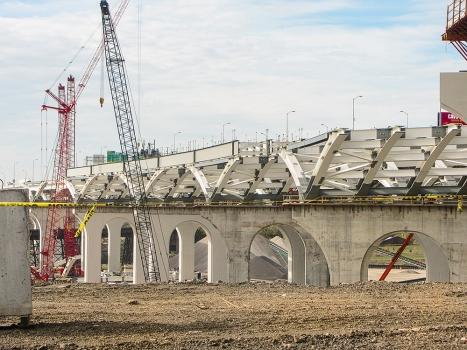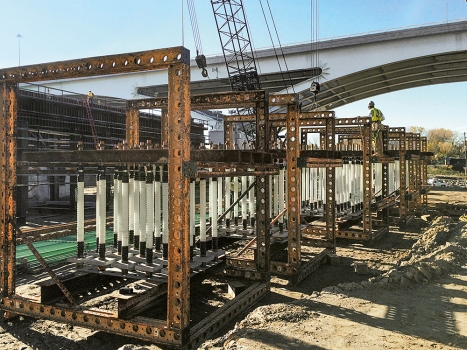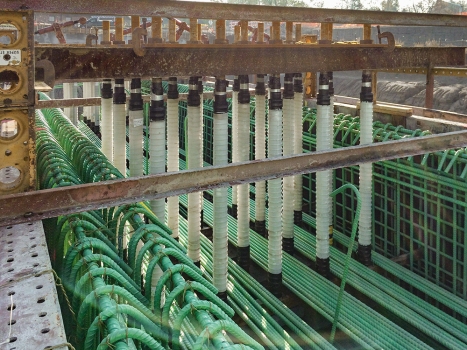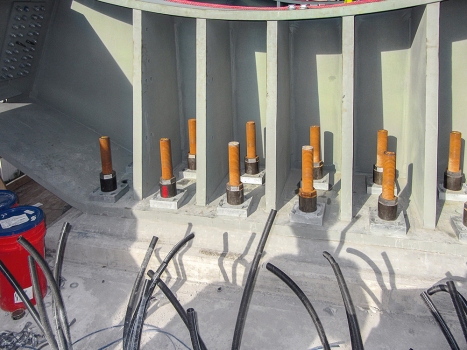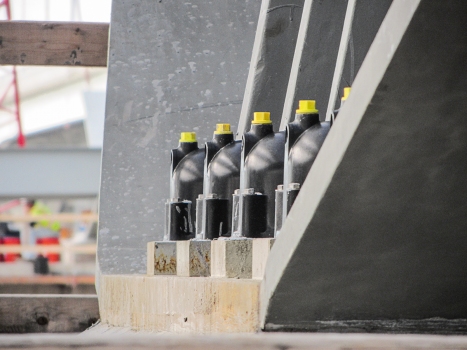Prefabricated tendons for George V. Voinovich Bridge in Cleveland, USA
The George V. Voinovich Bridge is part of the I-90 Interstate in Cleveland, Ohio, carrying vehicular traffic across the Cuyahoga River. The five lane structure replaces a truss bridge built in 1959 that had deteriorated badly and needed replacement. The new crossing consists of two sister structures, the first of which was completed in 2013. Until the completion of the second bridge, for traffic into the eastern direction, the first structure continued to accommodate the total traffic volume of approximately 140,000 vehicles per day.
Media
The main bridge is approximately 1,195 m (3,920 ft) long and consists of two units. The first part – the approach bridge – is a four span conventional steel plate girder bridge. The second part is a 10-span, five girder line, steel plate girder bridge supported by steel delta frames. The span lengths vary from 82.3 to 110 m (270 to 361 ft). Both bridge decks have a total width of approximately 30.5 m.
The longest HP piles ever manufactured in the USA
With a length of approximately 27.4 m (90 ft), the 18 x 204 HP piles are the largest ever manufactured in the USA. The steel piles were hammered up to 61 m (200 ft) deep into the underlying stable bedrock.
The piers rest on two concrete blocks that measure 8.5 x 8.5 x 2.6 m (28 x 28 x 8.5 ft). The columns of the piers were built in three sections, with the last section cantilevering laterally. The columns have a hollow core in order to reduce the overall weight of the bridge structures. On top of the two columns is a solid reinforced pier cap joining them together. There are five pedestals on top of each pier cap. Five groups of 20-24 post-tensioning bars are embedded multiple feet in to each pier cap, pass through the pedestal, and protrude several feet above, so structural steel can be positioned onto the bars and they can still be stressed.
After pier cap concrete placement, the top of the bar tendons were required to pass through an area where a grout pad would be poured after the setting of knuckles (at the bottom of the delta), prior to the completion of the delta frame erection. While placing the grout pad, it was critical that the fluid grout pad material did not enter the ducts and cause blockage or prevent proper tensioning of the tendons. Furthermore, the interface between the delta frame base plate and the grout pad had to be sealed against moisture intrusion.
DSI developed a groutable system meeting both the owner's requirements for durability and satisfying requirements in terms of installation. The bar tendons were required to be stressed to approximately 72 % of their ultimate strength, after the setting of the knuckle (at the bottom of the delta), but before the rest of the delta frame was erected.
980 preassembled tendons with a total weight of 65 t were installed
In order to eliminate the complicated site assembly requirements for tendons, DSI proposed a preassembled, pick and place tendon system that could be flexibly used, thus saving the contractor time and labour. The bar tendons were assembled in DSI Construction USA's Bolingbrook facility and then sent to the jobsite. In total, 300 46mm Ø bar tendons with a total weight of 12 t and 680 66mm Ø tendons with a total weight of 53 t were needed.
The contractor placed the tendons in a jig held by setting templates at both top and bottom that was used to fly the tendons into place.
References
Structure Types
- About this
data sheet - Product-ID
7495 - Published on:
15/05/2017 - Last updated on:
17/11/2021

